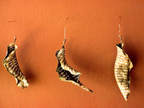Michael Maranda
Invisible Hand
lifesized leaves, 28x36cm prints
378 inkjet prints, 189 leaves, ink
2000
statement . . .
“My studies consist in Adam Smith and Locke… .”
–
Charles Darwin, in a letter dated 1829
Popular critiques of genetically modified organisms manifest themselves all too often in fears of contamination,
of the transgressing of boundaries, and of hostile takeovers of ‘natural’ species — all three arising
from the tradition of Darwin's evolutionary theory. If the question of the economics of GMOs is raised, it is only after
the main threats have been outlined, in the not very advanced formulation of “All Multinational Corporations are bad;
Monsanto is a multinational corporation; Therefore Monsanto (and its products) are bad.” While the logic (and the
underlying assumptions) are impeccable, the absence of subtlety in the rhetoric is suspect.
The defence of GMOs by Monsanto (and others) seems to be a reversal of the criticisms put to it (‘GMOs will allow
us to feed the hungry and benefit the Third World, and you aren't against the Third World, are you? And besides, GMOs are
safe — just like natural evolution. Trust us … and free-market capitalism.’)
Ironically, to approach a more nuanced critique of the issues surrounding GMOs
merely requires looking at the apparent and implied source in both arguments
(Darwin) in order to uncover the hidden source. Darwin, like most Victorian
intellectuals, was strongly influenced by none other than Adam Smith's The
Wealth of Nations. The very rhetoric of Darwin's theory can appear as nothing
more than a natural-law justification for market capitalism: The struggle for
existence between and within species justifies the free-market; the self-regulating
system of Natural Selection the correlate to Smith’s “invisible
hand”; the assumption of an ethically neutral system populated by individuals
who act as free (moral) agents is argued in Smith, and assumed by Darwin. At
present, the environmental seeds of dissent against GMOs are rooted in the very
theory that naturalised capitalism.
By bringing into contact key passages of Darwin’s Origin of Species
(Chapters 3, “The Struggle for Existence” and 4, “Natural
Selection”) and Smith’s The Wealth of Nations (Book 3, “Of
the Different Progress of Opulence in Different Nations”), I hope to underline
the similarities of these two systems of rhetoric, and thus to point (obliquely,
to be sure) to the same overlapping rhetorics in the debates surrounding GMOs.
Furthermore, by writing these texts on the leaves of rubber plants (as indexical
sign of late 19thc. mercantile capitalism, iconic sign of the origins of economic
neo-colonialism, and, as a tropical plant, another sign of environmental politics)
I want to suggest that maybe both sides of the GMO argument have fallen into
the trap that Darwin has set for us — that our ideas concerning the history
of nature have at heart a justification for the free market system.
The installation includes two sets of inkjet prints, each consisting of 189
28x26cm2 prints. The first series is scans of the recto of the freshly
‘written’ leaves, the text by Smith. The second series consist of
the verso (bottom) of the leaves, which have Darwin’s text. Along with
the inkjet prints are the leaves themselves, dried out and hanging from copper
wires embedded into the wall and hung in a grid the same size as that of the
series of prints.
Invisible Hand also exists as a limited edition two volume bookwork. The books, each 196 pages (30x30x5cm3),
are printed on Arches paper and hand sewn, coptic style, onto pearwood spines.
exhibitions . . .
2004
• Solo. “Bibliomania,” University of Lethbridge Art Gallery (Lethbridge AB), curated by Josephine Mills
2003
• Solo. “Recent Books,” Lutrin de l’étude (Montréal)
2001
• Solo. “Invisible Hand,” AKA Gallery (Saskatoon)
• Solo. “Invisible Hand,” Axe Neo-7 (Hull QC)
reviews . . .
2001
• Dahle, Sigrid. “White Out,” Bordercrossings 20:3 (September 2001), pp. 82-84.
collections . . .
• Lethbridge University Art Gallery
